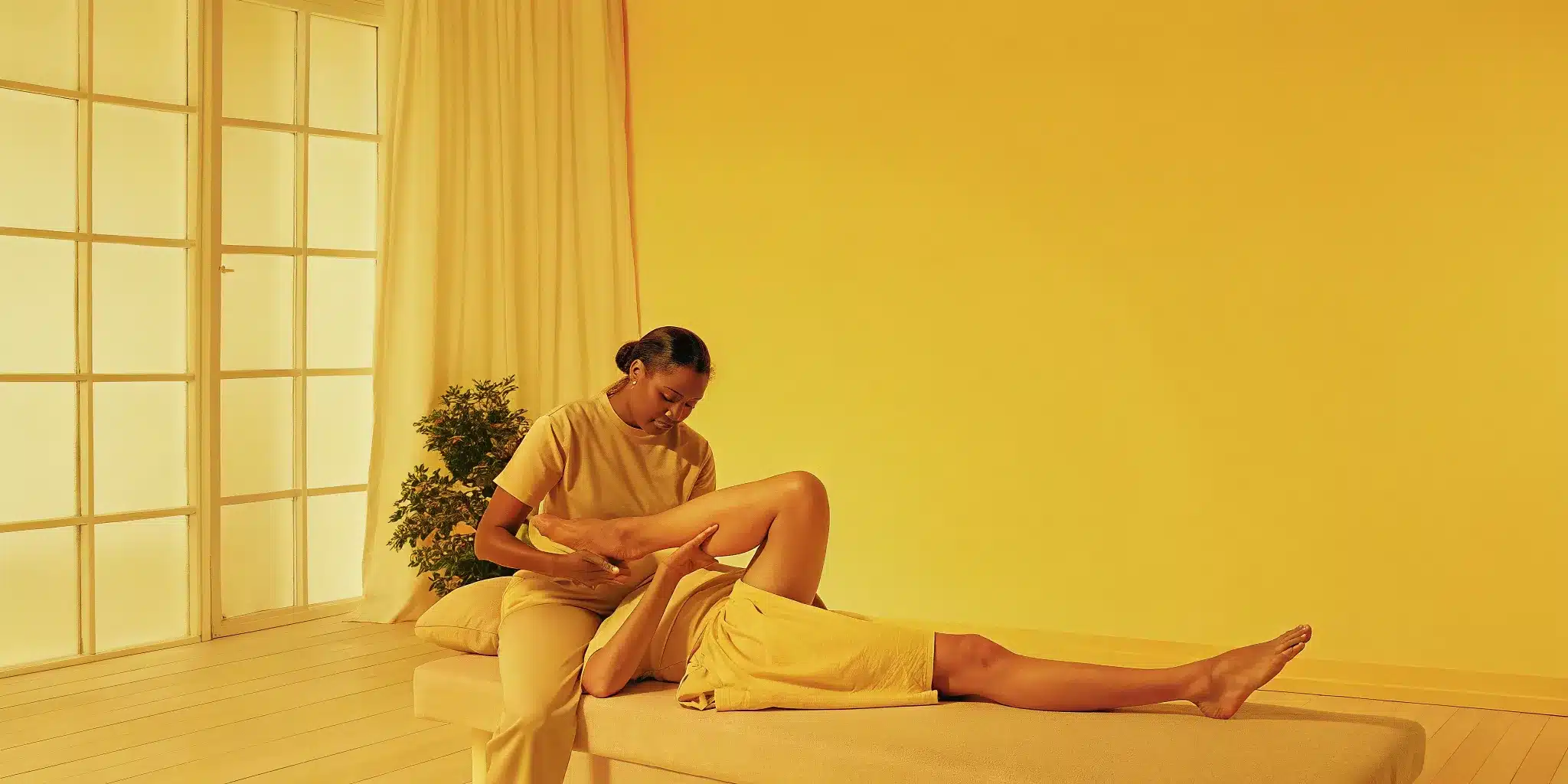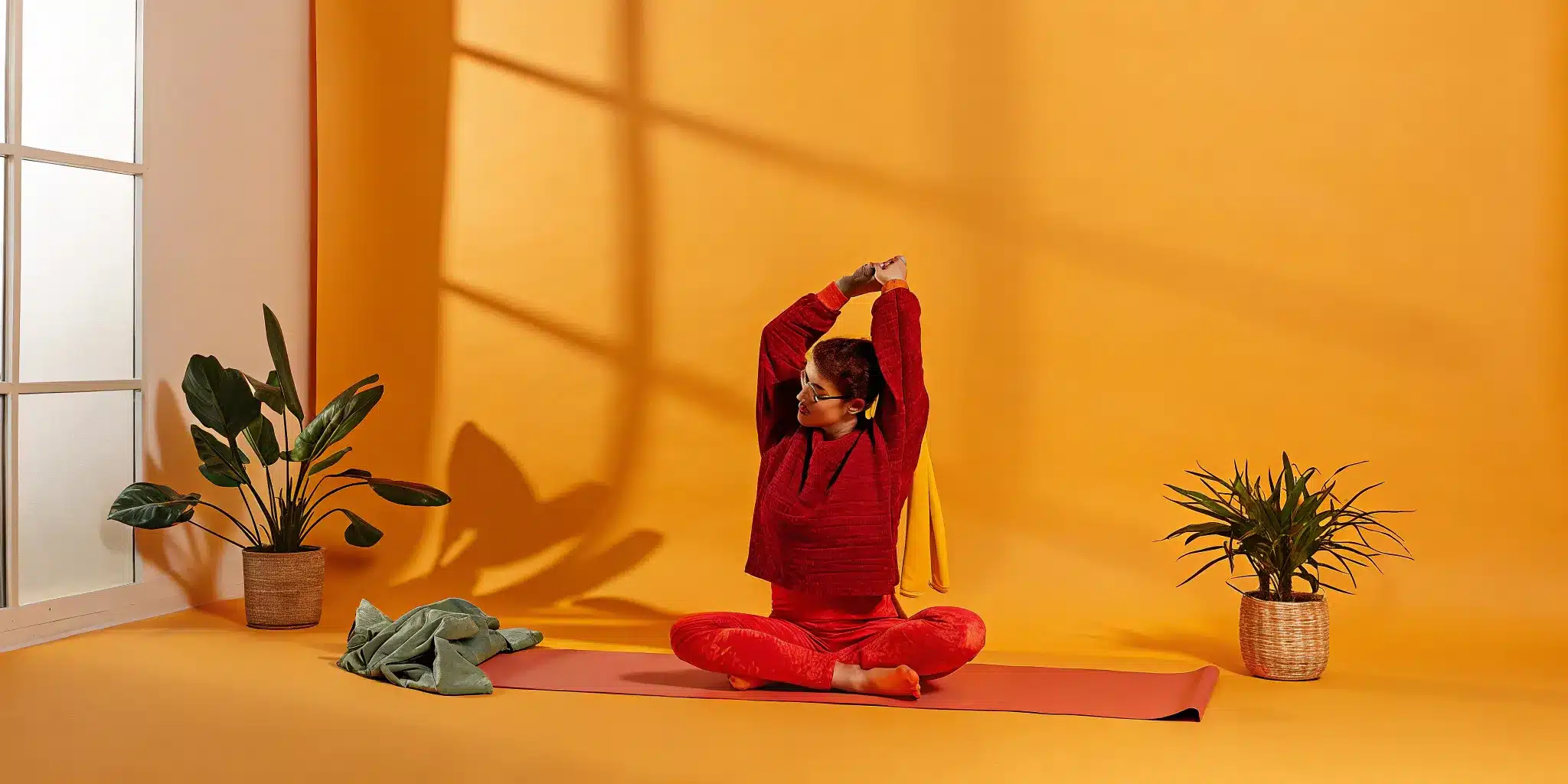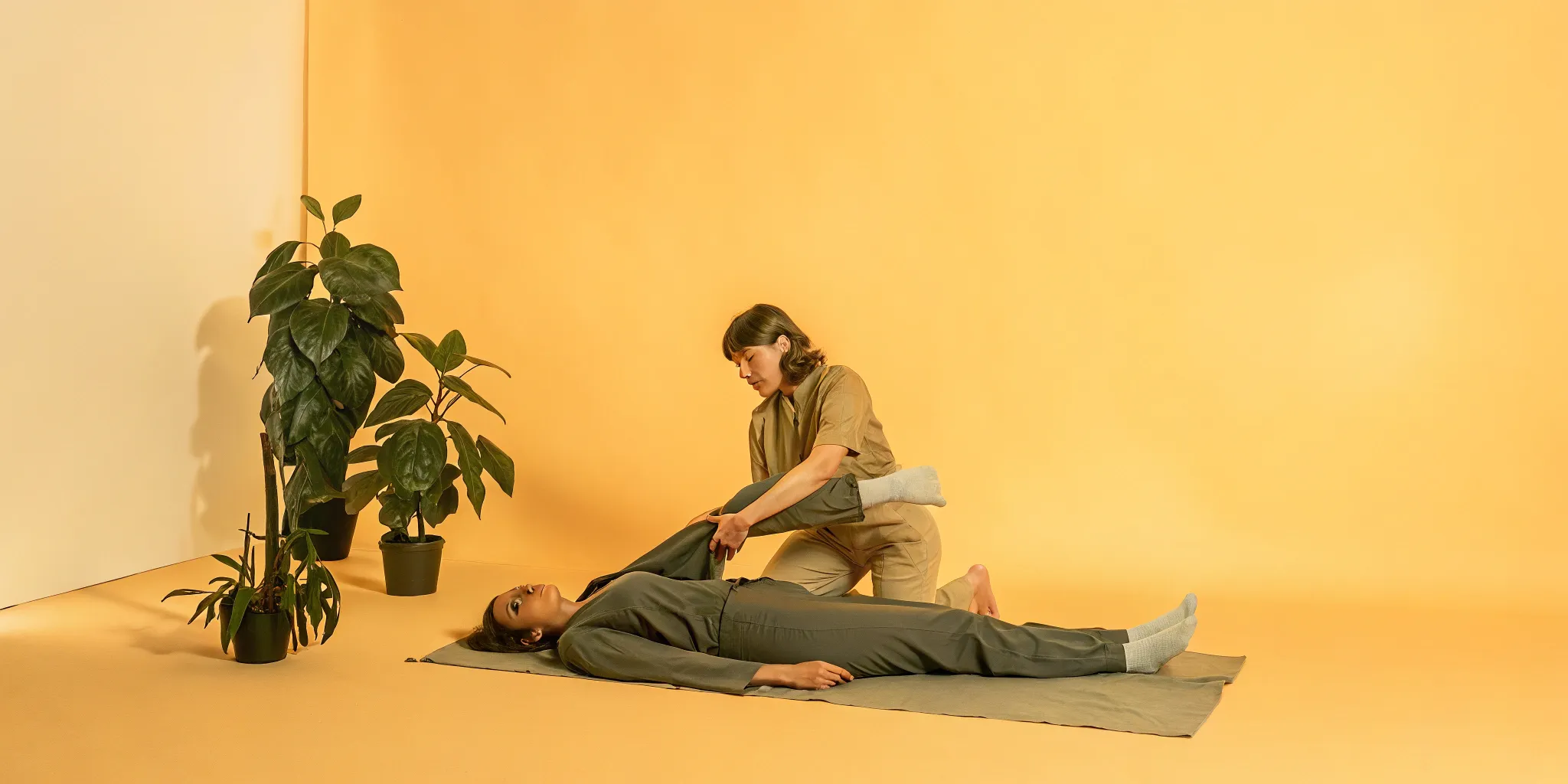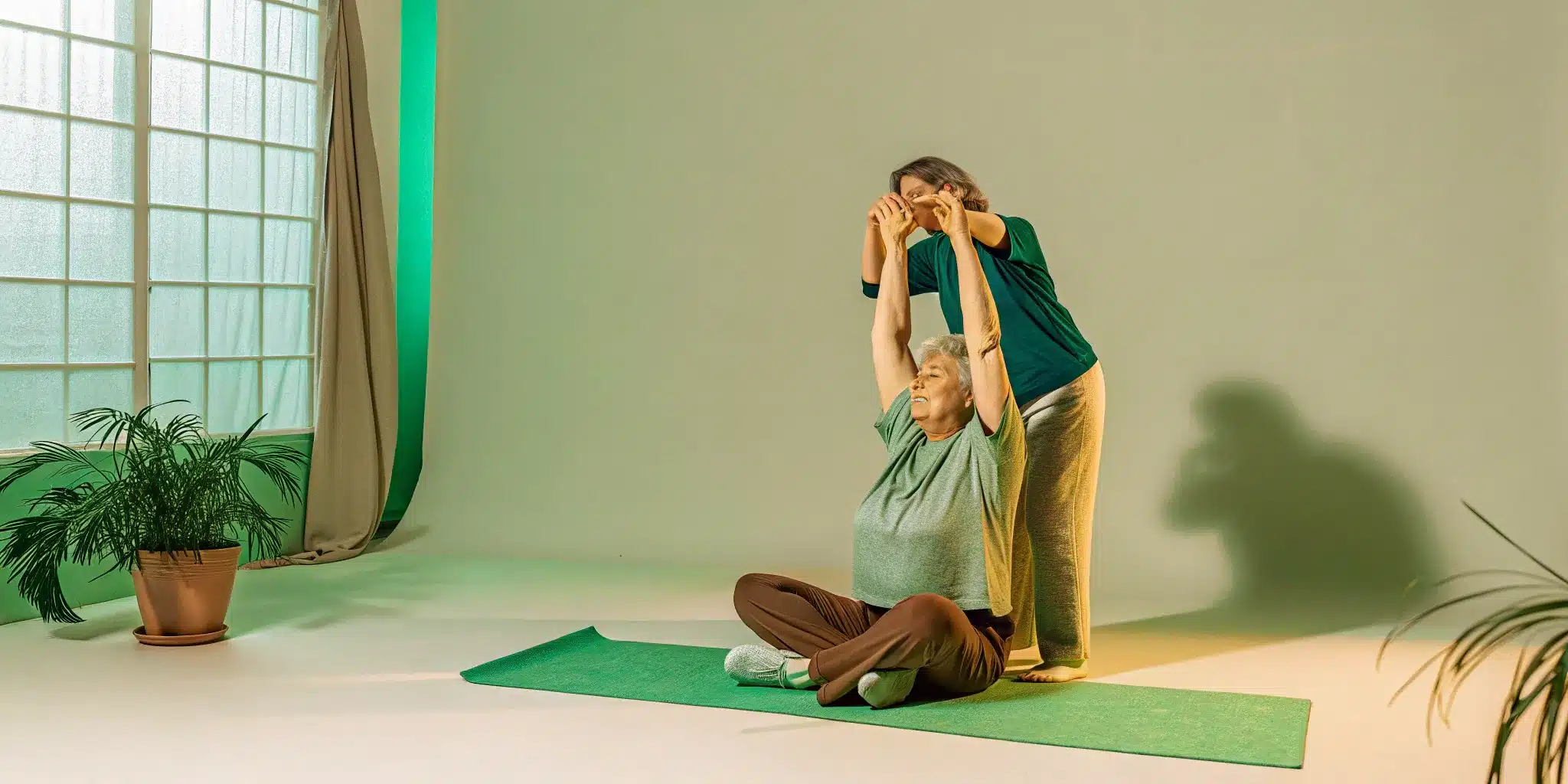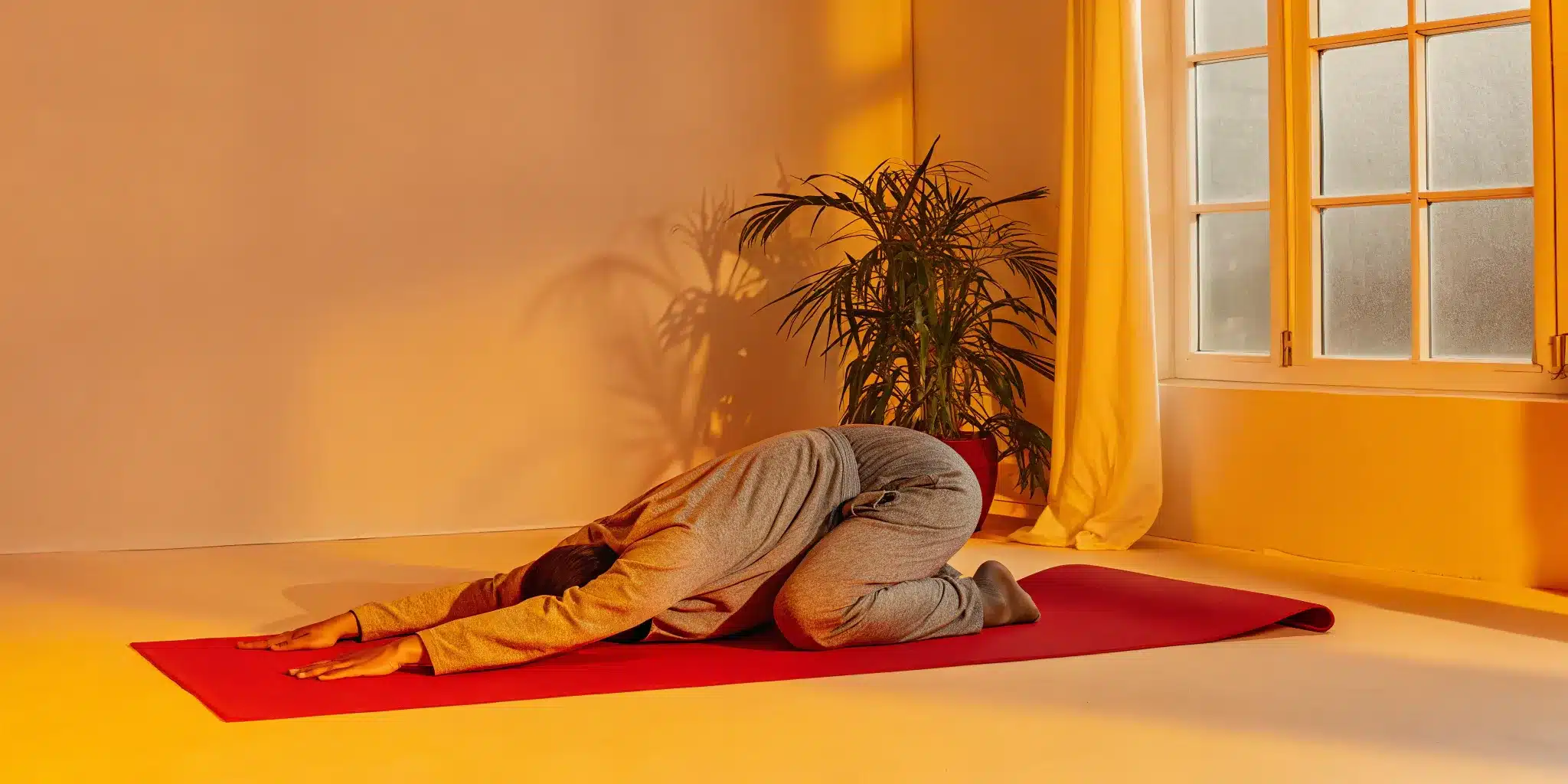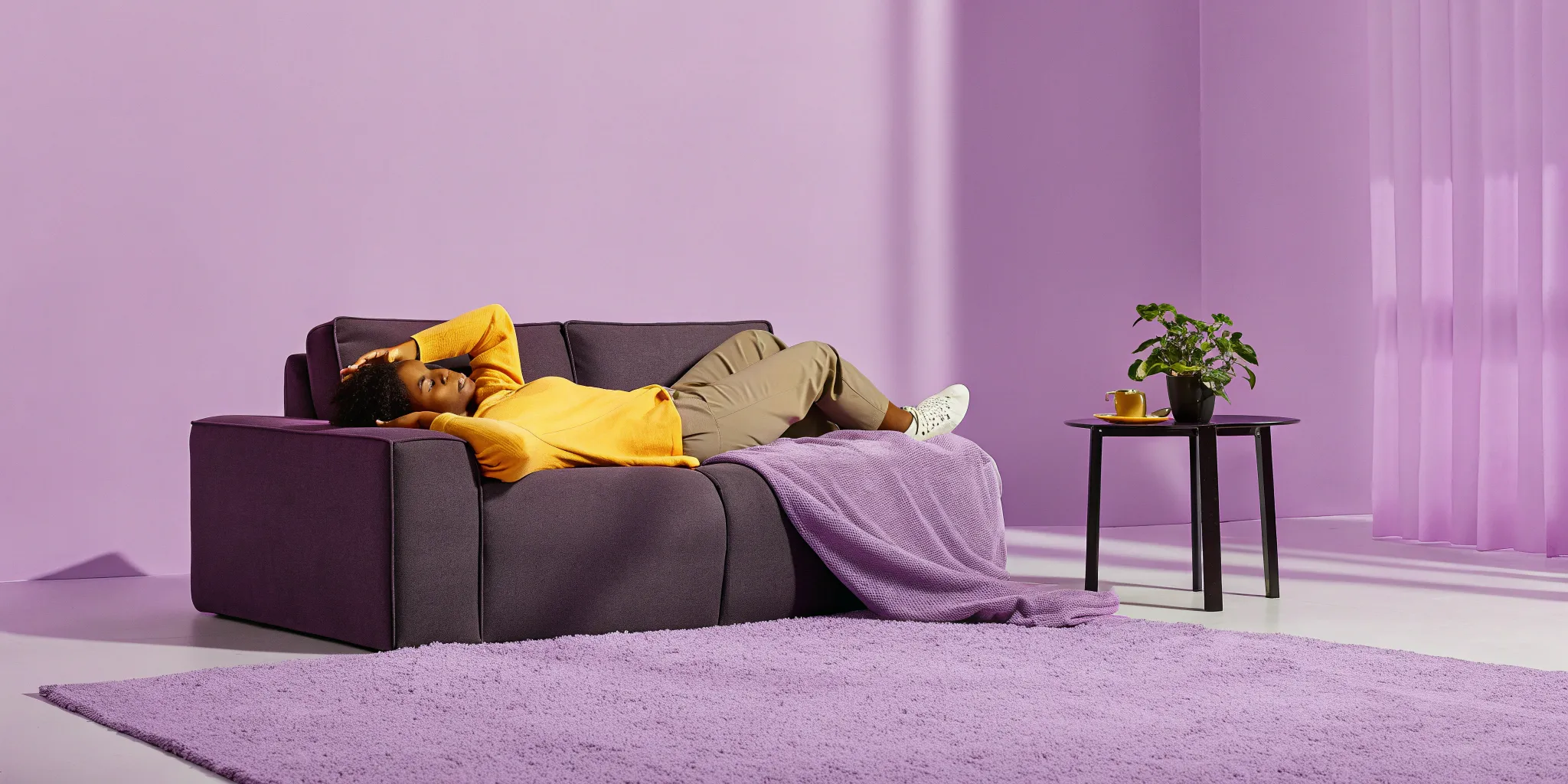We often think of physical tension as just that—physical. But the stress you hold in your shoulders or the tightness in your hips can have a huge impact on your mental state, affecting everything from your sleep quality to your ability to focus. Assisted stretching provides a unique opportunity to address both body and mind. As a therapist helps your body release long-held tension, you’re also letting go of mental and emotional stress. It’s a dedicated time to breathe, relax, and find a sense of calm. The 1-on-1 stretch therapist benefits extend far beyond improved flexibility; they include a clearer mind, better sleep, and a deeper connection to your own body. We’ll cover how releasing physical knots can help you feel more centered and resilient in your daily life.
Key Takeaways
- Partner with a Pro for Deeper Results: A trained therapist uses specialized techniques to guide your body into a more effective stretch than you can achieve alone, safely releasing deep-seated tension and improving your range of motion.
- It’s More Than Just Flexibility: Assisted stretching offers comprehensive benefits that go beyond your muscles, helping to alleviate chronic pain, correct posture, reduce stress, and even improve your sleep.
- Your Progress is a Personalized Journey: The process is tailored to you, starting with a full-body assessment to create a custom plan. Lasting results come from this consistent, one-on-one guidance that adapts as your body changes.
What is 1-on-1 Assisted Stretching?
If you’ve ever tried to stretch a tight hamstring or a sore back on your own, you know there’s a limit to how far you can go. One-on-one assisted stretching is exactly what it sounds like: a trained professional works with you to move your body through a series of gentle, targeted stretches. Think of it as personal training, but for your flexibility and mobility. It’s a partnership where an expert guides your limbs, helping you achieve a deeper and more effective stretch than you ever could by yourself.
This isn’t about pushing you into painful positions. It’s a controlled and personalized experience designed to release tension, reduce pain, and restore your range of motion. Unlike a yoga class or a group stretch session, every moment is tailored to your body’s specific needs and limitations. The therapist can isolate muscles you might not even know are tight and use their expertise to help them relax and lengthen safely. This focused attention is what makes assisted stretch therapy such a powerful tool for anyone looking to move better and feel better in their daily life.
How Assisted Stretching Works
When you stretch on your own, your body’s natural defense mechanism—the stretch reflex—kicks in to prevent you from overdoing it. This is a good thing, but it can also limit your progress. With an assisted stretch, a trained therapist can gently guide you past this point, encouraging your muscles to relax and lengthen more fully. They understand how to approach each muscle group to get the best results without causing strain. This allows for a much deeper and more productive stretch, targeting the root causes of tightness and discomfort in a way that’s both safe and incredibly effective.
A Look at Professional Techniques
Our stretch therapists aren’t just enthusiasts; they’re highly trained professionals. Each one holds a degree in a field like kinesiology or exercise science and completes a rigorous 100-hour certification program. They use specialized methods like PNF (proprioceptive neuromuscular facilitation)—a technique that involves contracting and relaxing muscles to deepen the stretch—and classic static stretching. To round out your session, they often use percussion therapy tools. These devices deliver rapid pulses into the muscle tissue, helping to release knots, improve circulation, and accelerate your body’s recovery process. It’s this combination of expertise and advanced stretching methods that delivers real results.
What to Expect in Your First Session
Your first visit is all about getting to know you and your body. We start with a comprehensive MAPS assessment that includes a full-body scan using special Physmodo technology. This isn’t as intimidating as it sounds; it’s a simple process that gives us a clear picture of your posture, mobility, and any imbalances you might have. This data allows us to create a completely personalized stretch plan designed to address your specific goals, whether that’s relieving back pain, improving your golf swing, or simply being able to touch your toes again. From there, you’ll get on the table for your first customized stretch session.
A Closer Look at Professional Stretching Techniques
When you come in for a 1-on-1 assisted stretching session, you’re getting much more than just a helping hand. Our certified stretch therapists are trained in specific, professional techniques designed to safely and effectively increase your mobility and relieve pain. It’s a personalized approach that goes far beyond the basic stretches you might do at home after a workout.
Think of your therapist as a knowledgeable guide for your body. They understand how your muscles work together and can identify areas of tightness you might not even be aware of. Using a combination of methods, they work with your body—never against it—to release tension, lengthen muscles, and restore your natural range of motion. This isn’t a one-size-fits-all routine; it’s a dynamic process tailored to your unique needs and goals. Let’s walk through some of the core techniques you’ll experience in a session.
Passive Stretching: Relax and Lengthen
This is where you get to completely relax and let your therapist do the work. During passive stretching, you’ll lie comfortably on a table while your therapist gently moves your limbs through different ranges of motion. Because you aren’t contracting any muscles, your body can fully release, allowing for a deeper and more restorative stretch than you could typically achieve on your own. This technique is fantastic for calming your nervous system and lengthening tight muscles, making it a cornerstone of 1-on-1 stretching for wellness. It’s the ultimate way to let go of tension and allow your body to find a new level of flexibility.
Active Stretching for Deeper Results
Active stretching is more of a partnership between you and your therapist. In this method, you’ll be asked to gently engage specific muscles to resist or assist the movement while your therapist guides you into a deeper stretch. This active participation helps your body build strength and stability in your newfound range of motion. By activating the opposing muscle to the one being stretched, you encourage the target muscle to relax even further. This approach can significantly enhance flexibility and is particularly effective for improving joint mobility and re-educating your muscles to move more freely and efficiently.
Tools That Help: Percussion and More
To give you the best results, our therapists often incorporate advanced techniques and tools into your session. You might experience methods like Proprioceptive Neuromuscular Facilitation (PNF), a specialized technique that involves contracting and relaxing muscles to achieve a deeper release. We also use percussion therapy with professional-grade massage guns. These tools deliver rapid pulses into the muscle tissue, which helps release knots, increase blood flow, and warm up the muscles for a more effective stretch. These 1-on-1 assisted stretching methods help your muscles recover and relax more effectively than stretching alone.
How We Keep You Safe
Your safety and comfort are our top priorities. It’s normal to feel a sense of deep release and some intensity as your muscles are stretched, but you should never feel sharp pain. Our therapists are experts at reading your body’s cues and will communicate with you throughout the entire session to ensure the pressure is just right. They know exactly how far to take each stretch to be effective without pushing you past your limit. The entire experience is designed to remain within your personal comfort level, providing relief and relaxation, not discomfort. We’re here to help you heal and feel better, every step of the way.
How Assisted Stretching Transforms Your Body
Think of assisted stretching as a reset button for your body. It’s a dedicated time where a trained professional helps you move in ways you simply can’t on your own, gently pushing past your usual limits to create real, lasting change. This isn’t just about touching your toes; it’s about fundamentally improving how your body feels and functions every single day. From the moment you get off the table, you’ll likely feel lighter and more open. Over time, these sessions build on each other, leading to profound shifts in your mobility, comfort, and even your athletic performance. It’s a partnership that helps your body release long-held tension and rediscover its natural state of balance and ease.
Move Freely with Better Flexibility
Feeling stiff when you get out of bed or struggling to reach the top shelf? That’s your body asking for a better range of motion. Assisted stretching is one of the most effective ways to improve your flexibility. A trained therapist can isolate specific muscles and guide them through a deeper, more effective stretch than you could achieve alone. This process lengthens tight muscle fibers and improves the mobility of your joints. The result? Everyday movements become easier and more fluid. You’ll find yourself bending, twisting, and reaching with a newfound freedom that makes everything from gardening to playing with your kids feel more comfortable and natural.
Find Relief from Aches and Pains
Chronic aches and pains can make life miserable, but you don’t have to just live with them. Often, discomfort stems from muscle tightness and imbalances that place stress on your joints and spine. Assisted stretching directly addresses these root causes. By releasing tension in overworked muscles, we can help alleviate common issues like persistent low back pain, tight hips, and stiff necks. A stretch therapist knows exactly how to work with these problem areas, easing the strain and helping your body find a more balanced, pain-free alignment. It’s a gentle yet powerful way to manage discomfort and get back to feeling like yourself.
Stand Taller with Improved Posture
Years of sitting at a desk, looking down at a phone, or driving can take a toll on your posture, leading to that all-too-common forward slump. Assisted stretching helps counteract these effects by opening up the muscles in your chest, shoulders, and hips that pull you forward. As these areas become more flexible, it becomes easier for your body to maintain a natural, upright position. Better posture doesn’t just help you look more confident; it also reduces strain on your neck and back, which can prevent future pain and improve your breathing. You’ll leave your sessions feeling taller, lighter, and more aligned.
Protect Your Body and Recover Faster
Whether you’re an athlete, a weekend warrior, or recovering from an injury, keeping your muscles pliable is key to staying healthy. Stiff, tight muscles are more susceptible to strains and tears. Assisted stretching improves elasticity, making your body more resilient and less prone to injury. It also increases blood flow to your muscles, which delivers vital oxygen and nutrients that speed up the healing process. If you’re bouncing back from an injury or surgery, a therapist can help you recover safely by ensuring you stretch correctly without overdoing it, helping you get back on your feet sooner.
Gain an Edge in Your Favorite Activities
Want to add a few yards to your golf swing or feel more powerful on your morning run? Improved flexibility is your secret weapon. When your muscles can move through their full range of motion, you can generate more force, react quicker, and move with greater efficiency. Regular assisted stretching helps you achieve that optimal range, giving you a real advantage in any sport or physical activity you love. You’ll not only perform better but also recover more quickly afterward, meaning less soreness and more time doing what you enjoy. It’s a game-changer for anyone looking to get the most out of their body.
It’s Not Just Physical: Mind and Mood Benefits
When we talk about stretching, it’s easy to focus on the obvious wins: touching your toes again, getting through a workout without wincing, or just being able to pick something up off the floor without a second thought. But the benefits of releasing physical tension go far beyond your muscles and joints. Chronic pain and stiffness take a mental toll, leaving you feeling drained, stressed, and distracted. Assisted stretching offers a powerful way to address both sides of the coin, helping you not only feel better in your body but also find more calm and clarity in your mind. It’s about creating space—in your hamstrings, yes, but also in your head.
Melt Away Stress and Find Calm
Think about where you hold stress. Is it in your neck and shoulders after a long day at your desk? Or maybe a tight jaw you don’t even realize you’re clenching? Our bodies often keep a physical record of our mental stress. Assisted stretching helps you release that built-up tension. As your therapist gently works through tight spots, you’re not just loosening muscles; you’re letting go of the day’s worries. This process improves blood flow throughout your body, which can lead to a clearer mind and a welcome boost of energy. It’s a dedicated time to breathe, relax, and allow someone else to help your body and mind find a calmer state.
Finally Get a Good Night’s Sleep
Tossing and turning all night? Aching hips or a stiff back can make it impossible to get comfortable, and the stress that causes that tension doesn’t help either. If you’re struggling to get restorative rest, stretching might be the missing piece of your evening routine. According to experts, stretching can help reduce the stress and tension that often interfere with rest. By easing muscle tightness before bed, you can calm your nervous system and signal to your body that it’s time to wind down. This can lead to falling asleep faster, staying asleep longer, and waking up feeling more refreshed and ready for the day.
Connect with Your Body on a Deeper Level
In our busy lives, it’s easy to feel disconnected from our bodies, often ignoring subtle aches until they become loud, persistent problems. Assisted stretching creates a unique opportunity to tune back in. With a trained therapist guiding you, you can safely explore your body’s limits and capabilities. This approach targets muscles more deeply and effectively than you could on your own, fostering a greater awareness of your body and its specific needs. You’ll start to notice where you hold tension and learn how to release it. This mindful connection is empowering, helping you understand your body’s signals and take a more active role in your own well-being.
Clear Your Mind and Sharpen Your Focus
It’s hard to concentrate on a work project or be fully present with loved ones when you’re distracted by a nagging pain in your back or neck. Physical discomfort is a constant drain on your mental energy. By addressing the root cause of this discomfort, assisted stretching can free up significant mental space. When your body feels better, you can move with more ease, react faster, and recover more quickly. This physical freedom often translates directly into improved mental clarity and focus. With fewer physical distractions, your mind is better able to tackle complex tasks, stay engaged in conversations, and simply enjoy the moment without the background noise of pain.
Is Assisted Stretching Right for You?
Assisted stretching isn’t just for one type of person. Whether you’re an athlete, a desk worker, or someone dealing with daily aches, a personalized stretching routine can make a world of difference. It’s a powerful tool for anyone who wants to move more freely and feel better in their own body. If you find yourself in any of the situations below, one-on-one stretching could be exactly what you need to get back on track and feel your best. Let’s look at how it can help with your specific goals and challenges.
If You Sit at a Desk All Day
That familiar ache in your neck and lower back after a long day at the computer is your body’s way of telling you it needs to move. Hours of sitting can lead to tight hips, rounded shoulders, and persistent stiffness that’s hard to shake. Assisted stretching directly counters the negative effects of a sedentary job. A trained therapist can help you become more flexible and move your joints through their full range of motion. This targeted approach improves your posture, which can significantly reduce pain in your back, neck, and other joints, helping you feel more comfortable and energized throughout your workday.
If You’re Active and Want to Perform Better
Whether you’re a weekend warrior, a dedicated gym-goer, or a competitive athlete, you’re always looking for an edge. But tight muscles can limit your performance and leave you prone to injury. Regular assisted stretching can help you break through plateaus and reach new goals. By improving your flexibility and mobility, you can become stronger, move more efficiently, and react faster. It also helps you recover more quickly after tough workouts or competitions, so you can get back to training sooner and with less soreness. Think of it as essential maintenance for your body, keeping you in peak condition for the activities you love.
If You Live with Chronic Pain
Living with chronic pain can be exhausting, affecting everything from your mood to your ability to enjoy daily life. If you’re dealing with issues like persistent low back pain, muscle tightness, or general tension, assisted stretching offers a gentle yet effective path toward relief. A personalized stretching routine can address the root causes of your discomfort, such as muscle imbalances. Many people find that consistent sessions lead to less muscle and joint pain, better flexibility, and improved blood flow. For those seeking a non-invasive way to manage discomfort, stretching can help you regain control and find lasting comfort.
If You’re Bouncing Back from an Injury
Recovering from an injury or surgery requires a careful and considered approach. Pushing too hard can set you back, but not moving enough can lead to stiffness and a longer recovery time. Assisted stretching provides a safe, controlled environment to regain your mobility. A professional therapist understands how to work with your body’s limits and can target muscles more deeply and safely than you could on your own. They can guide you through specific movements designed to help you recover safely from injuries and restore function, giving you the confidence to get back to your life without fear of re-injury.
Your Path to Feeling Better
Deciding to work with a stretch therapist is a fantastic step toward taking control of your well-being. It’s a personalized journey, and it’s helpful to know what the road ahead looks like. Unlike a generic fitness class, 1-on-1 assisted stretching is a structured process designed entirely around you, your body, and your goals. From the moment you walk in, the focus is on understanding your unique needs and creating a clear, actionable plan to help you feel and move better.
The process is straightforward and supportive. We start by getting to know your body, then we build a plan together. As you progress, we’ll be there to guide you, adjust your routine, and celebrate your wins. It’s a partnership aimed at helping you find lasting relief and freedom in your movement. Let’s walk through what you can expect.
Starting with Your Personal Assessment
Your first visit isn’t about jumping straight into stretches. It’s about discovery. We begin with a comprehensive, full-body assessment to understand your body’s unique patterns. This initial check helps us identify areas of tightness, muscle imbalances, and limitations in your range of motion. Think of it as creating a detailed map of your body. This step is crucial because it ensures your stretching plan is built on a solid foundation of information, not guesswork. It allows us to pinpoint the root causes of your discomfort and create a truly effective strategy for you.
Creating Your Custom Stretch Plan
Once we have a clear picture of your body’s needs, we create a stretching plan that is 100% customized for you. This isn’t a one-size-fits-all routine. Your plan is tailored to address the specific findings from your assessment and to help you reach your personal goals, whether that’s running a 5K without knee pain or simply being able to pick up your kids without a twinge in your back. We’ll walk you through each recommended stretch, explaining its purpose and how it contributes to your overall progress. This collaborative approach ensures you feel confident and empowered in your journey.
How We’ll Track Your Progress
Getting started is simple. After your initial assessment and custom plan are ready, you just need to book your first appointment. From there, progress isn’t just something you feel—it’s something we actively monitor. In each session, your therapist will check in with you, noting changes in your flexibility, pain levels, and overall movement. This continuous feedback loop allows us to make real-time adjustments to your plan, ensuring you’re always working effectively toward your goals. We’ll celebrate milestones with you and adapt your routine as your body becomes stronger and more flexible.
What Results to Expect (and When)
While every body is different, most people start to feel a difference after just a few sessions. Initially, you might notice a sense of release and reduced tension. Over time, with consistent sessions, you can expect more significant changes. Assisted stretching can help you become more flexible, improve your posture, and find lasting relief from chronic aches in your back, neck, or joints. Many clients also experience a lower risk of injury during physical activities. The key is consistency. Committing to your plan is the best way to achieve profound, long-term results and truly transform how you move.
How to Find the Right Stretch Therapist
Choosing a stretch therapist is a personal decision. You’re trusting someone with your body and your wellness goals, so it’s important to find a professional who is not only qualified but also a good fit for you. The right therapist acts as your partner, guiding you safely toward better mobility and less pain. They should listen to your needs, respect your body’s limits, and create a supportive environment where you feel comfortable. Think of it like finding any other trusted health professional—a little research and asking the right questions upfront can make all the difference in your experience and your results. Taking the time to find the right person ensures your journey to feeling better starts on the right foot.
What to Look For in a Therapist
When you start your search, look for a therapist with a strong educational background and specialized training. Many of the best professionals come from fields like kinesiology, physical therapy, massage therapy, yoga, or sports medicine. This experience gives them a deep understanding of body mechanics and how the muscular system works. Don’t be shy about asking about their certifications and where they received their training. A great therapist is proud of their credentials and happy to share them. This expertise ensures they can tailor stretches to your specific needs, whether you’re dealing with chronic tightness from a desk job or preparing for a marathon.
Making Sure They Prioritize Your Safety
Your safety should always be the top priority. A key principle of effective assisted stretching is that it should not be painful. You might feel a deep stretch or some mild discomfort as your muscles lengthen, but you should never feel sharp or intense pain. A skilled therapist knows how to read your body’s cues and will constantly check in with you. They should encourage open communication and immediately adjust the pressure or angle if you feel any real pain. This collaborative approach is crucial for preventing injury and making sure each session is both productive and positive. A safe session is a successful one.
Questions to Ask Before Your First Session
Before you commit, have a conversation with a potential therapist. This is your chance to get a feel for their approach and ensure they understand your goals. Ask them how they customize sessions for individual clients and what a typical session looks like. It’s also a great time to share your history, including any past injuries or areas of chronic pain. Most importantly, let them know that you’ll speak up if a stretch feels too intense. Their response will tell you a lot. A good therapist will welcome your feedback and see it as an essential part of the process, not an interruption.
Red Flags to Watch Out For
As you search, keep an eye out for a few warning signs. Be cautious if a therapist suggests that stretching has to be painful to be effective. This “no pain, no gain” mentality is outdated and can lead to injury. Another red flag is a professional who downplays the value of one-on-one guidance, suggesting you could easily get the same results on your own. While at-home stretching is beneficial, it doesn’t replace the precision and personalization of an assisted session. These kinds of myths about assisted stretching often point to a lack of specialized knowledge and experience. Trust your gut—if something feels off, it probably is.
Get the Most Out of Every Session
Your time with your stretch therapist is incredibly valuable. To really see and feel the changes you’re looking for, it helps to think of your sessions as the cornerstone of your wellness plan. What you do between appointments can make a huge difference in your progress and how long the benefits last. Here’s how you can support the work we do together and get the most out of every single session.
How Often Should You Come In?
“How often should I come in?” is one of the first questions people ask, and it’s a great one. For most healthy adults, the ideal stretching routine involves working all major muscle groups at least two to three times a week. This consistency is what helps you not just gain flexibility, but maintain it. Think of it like this: each session builds on the last, gently encouraging your muscles to release tension and find a new, more comfortable range of motion. Coming in regularly keeps that momentum going, leading to lasting relief and improved mobility.
What to Do Between Your Sessions
It’s natural to want to keep the good feelings going between your appointments. While doing some light stretching on your own is great for maintenance, it’s important to remember why assisted stretching is so effective. A trained therapist can target muscles more deeply and safely than you can on your own, guiding your body into stretches that are difficult or impossible to achieve alone. Your therapist can give you simple movements to do at home that complement our work, but the real, transformative changes happen here in the studio, where we can ensure you’re getting the most effective stretch possible.
Simple Lifestyle Changes for Big Results
You don’t need to overhaul your entire life to feel better. Often, the smallest adjustments make the biggest impact. If you work at a desk, try setting a timer to get up and walk around for a few minutes every hour. Pay attention to your posture while driving or standing in line. Staying hydrated is also crucial for muscle health. Adding these small habits to your day doesn’t take much time, but they can make a huge difference in how flexible and comfortable your body feels, supporting the progress you make in your sessions.
Making Stretching a Part of Your Life
The goal isn’t just to fix a temporary ache; it’s to integrate mindful movement into your life for long-term well-being. When you make stretching a consistent practice, you’ll start to notice benefits that go beyond just feeling less stiff. Assisted stretching offers so many advantages for your body and mind, from standing taller with better posture to feeling less stressed after a long day. It can even improve your performance in sports and other activities you love. By committing to your sessions, you’re investing in a healthier, more mobile, and more comfortable you.
Related Articles
- STRETCHMED – Committed To Helping You Move Well
- StretchMED First Time Experience – STRETCHMED
- StretchMED Kent Island – STRETCHMED
- StretchMed Palm Harbor – STRETCHMED
- Stretch Media Landing Design – STRETCHMED
Frequently Asked Questions
Is assisted stretching supposed to hurt? Absolutely not. While you will feel your muscles being worked in a deep and meaningful way, you should never feel sharp or shooting pain. A good stretch therapist is an expert at listening to your body and will communicate with you constantly to ensure the pressure is productive, not painful. The goal is to release tension and create space, and that can only happen when your body feels safe enough to relax into the movement.
How is this different from stretching on my own or in a yoga class? Think of it as the difference between a group fitness class and a personal training session. When you stretch on your own or in a class, you’re following general cues. In a one-on-one session, every movement is tailored specifically to your body’s needs. A trained therapist can isolate muscles you might not be able to target on your own and use advanced techniques to gently guide you past your usual limitations for a much deeper and more effective release.
Do I need to be flexible to start assisted stretching? That’s like asking if you need to be in shape before you hire a personal trainer! A lack of flexibility is precisely why people seek out assisted stretching. Our service is designed for everyone, especially those who feel stiff, tight, or limited in their movement. We meet you exactly where you are and create a plan to help you safely and gradually improve your range of motion.
How soon will I feel a difference? Many people feel an immediate sense of lightness and relief after their very first session. You might stand up from the table feeling taller and more open. While that initial feeling is wonderful, the most profound and lasting benefits—like reduced chronic pain, better posture, and improved athletic performance—come from consistency. Regular sessions build on each other to create real, sustainable change in your body.
What should I wear to my appointment? You should wear comfortable clothing that you can move in easily. Think of what you might wear for a workout or a yoga class. Athletic pants, leggings, joggers, or comfortable shorts, along with a t-shirt or tank top, are all great choices. The key is to wear something that won’t restrict your movement as your therapist guides your limbs through their full range of motion.

